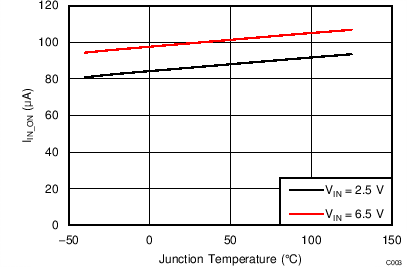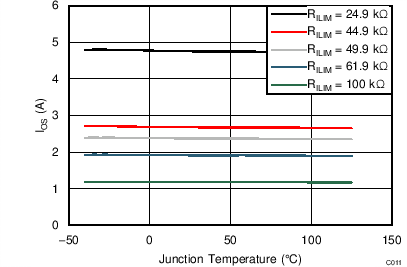7 Specifications
7.1 Absolute Maximum Ratings
over operating free-air temperature range (unless otherwise noted) (1) (2)
|
|
MIN |
MAX |
UNIT |
| Voltage range |
IN, OUT, EN, ILIM, FAULT |
–0.3 |
7 |
V |
| IN to OUT |
–7 |
7 |
V |
| Continuous output current, IOUT |
OUT |
Internally Limited |
mA |
| Continuous FAULT sink current |
|
20 |
mA |
| ILIM source current |
Internally Limited |
mA |
| Maximum junction temperature, TJ |
–40 |
to OTSD2 |
°C |
| Storage temperature, Tstg |
–65 |
150 |
°C |
(1) Stresses beyond those listed under Absolute Maximum Ratings may cause permanent damage to the device. These are stress ratings only, which do not imply functional operation of the device at these or any other conditions beyond those indicated under Recommended Operating Conditions. Exposure to absolute-maximum-rated conditions for extended periods may affect device reliability.
(2) Voltages are referenced to GND unless otherwise noted.
7.2 ESD Ratings
|
VALUE |
UNIT |
| V(ESD) |
Electrostatic discharge(1) |
Human body model (HBM), ESD stress voltage, all pins(2) |
±2000 |
V |
| Charged device model (CDM), ESD stress voltage, all pins(3) |
±750 |
| System Level (4) |
Contact discharge |
±8000 |
| Air discharge |
±15000 |
(1) Electrostatic discharge (ESD) to measure device sensitivity or immunity to damage caused by assembly-line electrostatic discharges into the device.
(2) The passing level per AEC-Q100 Classification H2.
(3) The passing level per AEC-Q100 Classification C5.
(4) Surges per EN61000-4-2, 1999 applied between USB and output ground of the TPS2559EVM (
SLUUB15) evaluation module (documentation available on the Web.) These were the test levels, not the failure threshold.
7.3 Recommended Operating Conditions
over operating free-air temperature range (unless otherwise noted)
|
|
MIN |
MAX |
UNIT |
| VIN |
Input voltage, IN |
2.5 |
6.5 |
V |
| VEN |
Input voltage, EN |
0 |
6.5 |
V |
| IOUT |
Continuous output current of OUT |
|
5.5 |
A |
|
Continuous FAULT sink current |
|
10 |
mA |
| R(ILIM) |
Recommended resistor limit range (1) |
24.9 |
100 |
kΩ |
| TJ |
Operating junction temperature |
-40 |
125 |
°C |
(1) R(ILIM) is the resistor from ILIM pin to GND and ILIM pin can be shorted to GND.
7.4 Thermal Information
| THERMAL METRIC(1) |
TPS2559-Q1 |
UNIT |
| DRC (10 PINS) |
| RθJA |
Junction-to-ambient thermal resistance |
40.6 |
°C/W |
| RθJC(top) |
Junction-to-case (top) thermal resistance |
45.5 |
°C/W |
| RθJB |
Junction-to-board thermal resistance |
15.9 |
°C/W |
| ψJT |
Junction-to-top characterization parameter |
0.4 |
°C/W |
| ψJB |
Junction-to-board characterization parameter |
15.7 |
°C/W |
| RθJC(bot) |
Junction-to-case (bottom) thermal resistance |
2.8 |
°C/W |
(1) For more information about traditional and new thermal metrics, see the
IC Package Thermal Metrics application report,
SPRA953.
7.5 Electrical Characteristics
Conditions are –40°C ≤ TJ ≤ 125°C, 2.5 V ≤ VIN ≤ 6.5 V, V(EN) = VIN, R(ILIM) = 49.9 kΩ. Positive current are into pins. Typical value is at 25°C. All voltages are with respect to GND (unless otherwise noted).
| PARAMETER |
TEST CONDITIONS |
MIN |
TYP |
MAX |
UNIT |
| POWER SWITCH |
| RDS(on) |
Input - Output Resistance(1) |
TJ = 25°C |
|
13 |
16 |
mΩ |
| -40°C ≤ TJ ≤ 125°C |
|
|
21 |
| ENABLE INPUT EN |
|
EN turn on/off threshold |
|
0.66 |
|
1.1 |
V |
|
Hysteresis |
|
|
55(2) |
|
mV |
| I(EN) |
Input current |
V(EN) = 0 V or V(EN) = 6.5 V |
–1 |
|
1 |
µA |
| CURRENT LIMIT |
| IOS |
OUT short circuit current limit |
R(ILIM) = 24.9 kΩ |
4490 |
4730 |
4931 |
mA |
| R(ILIM) = 44.2kΩ |
2505 |
2660 |
2805 |
| R(ILIM) = 49.9kΩ |
2215 |
2360 |
2490 |
| R(ILIM) = 61.9 kΩ |
1780 |
1900 |
2015 |
| R(ILIM) = 100 kΩ |
1080 |
1180 |
1265 |
| ILIM pin short to GND (R(ILIM) = 0) |
5860 |
6700 |
7460 |
| SUPPLY CURRENT |
| I(IN_OFF) |
Disabled, IN supply current |
V(EN) = 0 V, No load on OUT |
|
0.1 |
2 |
µA |
| I(IN_ON) |
Enabled, IN supply current |
R(ILIM) = 100 kΩ, no load on OUT |
|
97 |
125 |
µA |
| R(ILIM) = 24.9 kΩ, no load on OUT |
|
107 |
135 |
| I(REV) |
Reverse leakage current |
VOUT = 6.5 V, VIN = 0 V, TJ = 25°C,
Measure IOUT |
|
0.01 |
1 |
µA |
| UNDERVOLTAGE LOCKOUT |
| VUVLO |
IN rising UVLO threshold voltage |
|
|
2.36 |
2.45 |
V |
|
Hysteresis |
|
|
35(2) |
|
mV |
| FAULT |
|
|
|
|
|
|
| VOL |
Output low voltage |
IFAULT = 1 mA |
|
|
180 |
mV |
|
Off-state leakage |
VFAULT = 6.5 V |
|
|
1 |
µA |
| THERMAL SHUTDOWN |
| OTSD2 |
Thermal shutdown threshold |
|
155 |
|
|
°C |
| OTSD1 |
Thermal shutdown threshold in current-limit |
|
135 |
|
|
|
Hysteresis |
|
|
20 (2) |
|
|
(1) Pulse-testing techniques maintain junction temperature close to ambient temperature. Thermal effects must be taken into account separately
(2) These parameters are provided for reference only, and don’t constitute part of TI’s published device specifications for purposes of TI’s product warranty.
7.6 Timing Requirements
Conditions are –40°C ≤ TJ = ≤ 125°C, 2.5 V ≤ VIN ≤ 6.5 V, V(EN) = VIN, R(ILIM) = 49.9 kΩ. Positive current are into pins. Typical value is at 25°C. All voltages are with respect to GND (unless otherwise noted).
| PARAMETER |
TEST CONDITIONS |
MIN |
TYP |
MAX |
UNIT |
| POWER SWITCH |
| tr |
OUT voltage rise time |
VIN = 6.5 V |
CL = 1 µF, RL = 100 Ω, See Figure 13 |
2.6 |
3.44 |
5.2 |
ms |
| VIN = 2.5 V |
1.3 |
2.01 |
3.9 |
| tf |
OUT voltage fall time |
VIN = 6.5 V |
0.7 |
0.89 |
1.3 |
| VIN = 2.5 V |
0.42 |
0.58 |
1.04 |
| ENABLE INPUT EN |
| ton |
OUT voltage turn-on time |
CL = 1 µF, RL = 100 Ω, See Figure 14 |
|
|
15 |
ms |
| toff |
OUT voltage turn-off time |
|
|
8 |
| CURRENT LIMIT |
|
| tIOS |
Short-circuit response time(1) |
VIN = 5 V, RSHORT = 50 mΩ, See Figure 15 |
|
3.5(1) |
|
µs |
| FAULT |
|
|
FAULT deglitch |
FAULT assertion or de-assertion due to overcurrent condition |
6 |
9 |
13 |
ms |
(1) This parameter is provided for reference only and does not constitute part of TI's published device specifications for purposes of TI's product warranty
7.7 Typical Characteristics
 Figure 1. Under-voltage Lockout (UVLO) vs Temperature
Figure 1. Under-voltage Lockout (UVLO) vs Temperature
 Figure 3. Supply Current, Output Enabled (IIN_ON) vs Temperature
Figure 3. Supply Current, Output Enabled (IIN_ON) vs Temperature
 Figure 5. Reverse Leakage Current (IREV) v. Temperature
Figure 5. Reverse Leakage Current (IREV) v. Temperature

| VIN = 6.5 V |
ILIM pin short to GND |
Figure 7. Short Circuit Current (IOS) vs Temperature

| COUT = 1 µF |
R(LOAD) = 100 Ω |
|
Figure 9. Output Rise Time (tR) vs Temperature
 Figure 11. Short Circuit Current (IOS) vs Temperature
Figure 11. Short Circuit Current (IOS) vs Temperature
 Figure 2. Supply Current, Output Disabled (IIN_OFF) vs Temperature
Figure 2. Supply Current, Output Disabled (IIN_OFF) vs Temperature
 Figure 4. Supply Current, Output Enabled (IIN_ON) vs Temperature
Figure 4. Supply Current, Output Enabled (IIN_ON) vs Temperature
 Figure 6. Input-Output Resistance (RDS(on)) vs Temperature
Figure 6. Input-Output Resistance (RDS(on)) vs Temperature
 Figure 8. Deglitch Time (tFAULT) vs Temperature
Figure 8. Deglitch Time (tFAULT) vs Temperature

| COUT = 1 µF |
R(LOAD) = 100 Ω |
|
Figure 10. Output Fall Time (tF) vs Temperature










